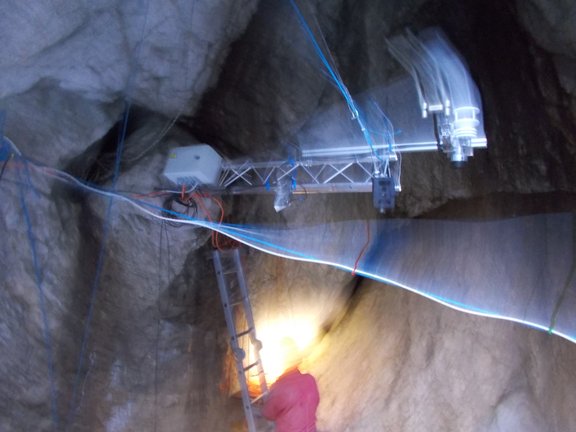Ice in Caves - a threatened climate Archive in the Alps

The Eastern Alps of Austria provide a backdrop for magnificent glaciers whose changes on short to long timescales have provided a benchmark for regional climate change. Beneath the surface, however, snow and ice deposits that have the potential to complement the surface archive can also be found locally. The east Alpine ice caves are among the largest on this planet, but compared to the wealth of research that has been carried out on mountain glaciers, these underground ice bodies are largely a terra incognita.
The overarching goal of this project is to explore the paleoclimate potential of these unique and under-studied archives contained in sag-type caves to obtain records of winter precipitation reaching back many hundreds of years. A selection of these caves across the Eastern Alps will be studied based on determining their internal stratigraphy using high-resolution radiocarbon dating and dendrochronology, establishing snow accumulation records for the last millennium, comparing them with both instrumental and glacier-derived records and exploring the potential of the hydrogen and oxygen isotopic composition of cave ice as a paleotemperature indicator, finally.
A second part of the project focuses on investigation of processes related to the existence and seasonal developments of the investigated ice bodies. This involves monitoring micrometeorology in and outside of the study caves to entangle the role of major drivers (radiation, turbulent exchange and conductive processses) for the snow/ice mass balance in cave systems. This part of the project further aims at establishing relationships between the outside weather conditions and the small-scale atmospheric conditions in ice-caves, which in the envisaged extent was not yet systematically carried out in the Alps or elsewhere. Based on an ongoing surveys, the investigations will start with Hundsalm Eishöhle (thereby taking advantage of longer-term monitoring activities by the project team), further studies will be performed at Guffert Ice Shaft and/or Großer Naturschacht.
Project Leader:
Christoph SPÖTL
Members:
Friedrich OBLEITNER (PI)
Maria WIND (PhD Student, ACINN )
Tanguy RACINE(PhD, Inst. of Geology)
Mathias ROTACH (PhD supervisor)
Collaborators:
Kurt Nicolussi (Institute of Geography, Univ. Innsbruck)
Oeggl Klaus (Dep. of Botany, Univ. Innsbruck)
Paula Reimer (Univ. Belfast)
Schöner Wolfgang (Univ. Graz)
Luetscher Marc (SISKA, Switzerland)
Funding Agencies:
Austrian Science Fund (FWF, P 31874)
Weiss Science Foundation
University of Innsbruck
Project Duration:
01/03/2019 – 28/02/2022
See some related links:
https://quaternary.uibk.ac.at/Research/Current-Research/Paleoclimate-caves/Ice-Caves.aspx
https://www.derstandard.at/story/2000100318712/weiss-preis-fuer-forschung-zur-kleinen-eiszeit
https://quaternary.uibk.ac.at/News/2018/Ice-cave-monitoring.aspx
https://quaternary.uibk.ac.at/News/2019/Field-work-on-Guffert.aspx
https://quaternary.uibk.ac.at/Research/Finished-Research/AUSTRO-ICE-CAVES-2100.aspx
https://www.the-cryosphere.net/special_issue10.html
https://www.the-cryosphere.net/5/245/2011/
https://quaternary.uibk.ac.at/News/2017/Ice-cave-encyclopedia.aspx
https://journals.sagepub.com/doi/10.1177/0959683613515729
https://quaternary.uibk.ac.at/News/2021/Ice-cave-field-work.aspx
https://www.daserste.de/information/wissen-kultur/w-wie-wissen/videos/eishoehle-video-100.html#
https://quaternary.uibk.ac.at/News/2020/3D-model-of-an-alpine-ice-cave.aspx
